Installation of proper lighting for corals helps to achieve an astonishing look. However, the installation of suitable light is not an easy task. You need to search for the best option for your coral tank. It is a time-consuming aspect. After that, setting it up, especially light settings for coral in mixed coral tanks is another great challenge. In the following article, you will find the answers to all your questions and ways out of these challenges, including the best light spectrum for coral growth.
Content Table
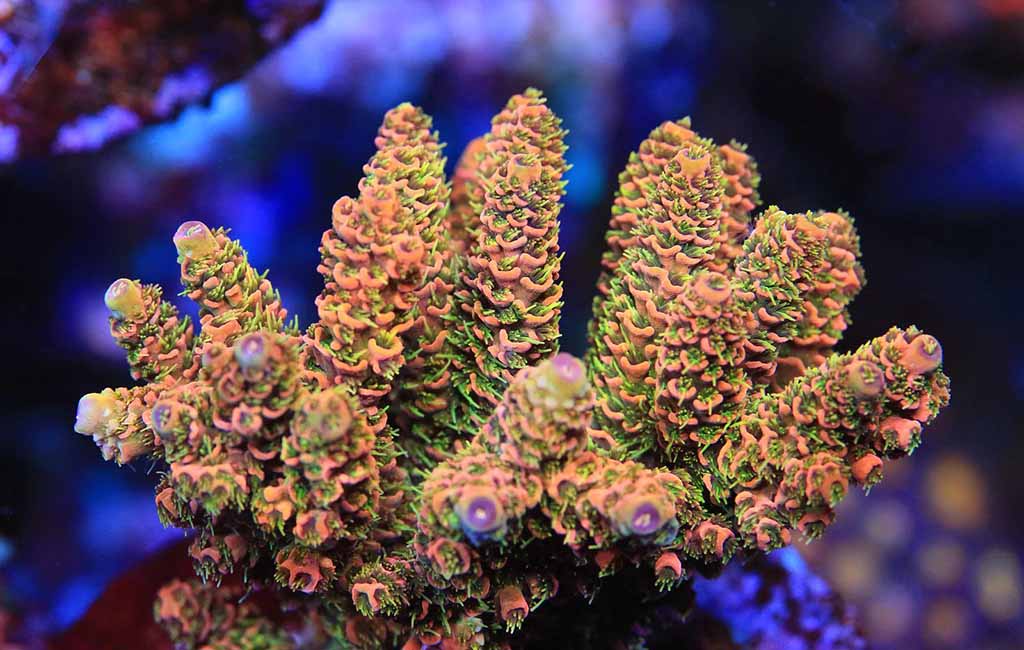
Lighting coral tanks
Beautiful Things Lighting Coral Tanks
Corals have fluorescent protein pigments that emit light, such as cyan, green, yellow, or red. These pigments reflect unnecessary light and avoid coral bleaching. We can use them to enhance the overall ambiance of the tank. Here are beautiful aspects that light highlights in coral tanks.
Moonlight Mode
Moonlight helps the coral in spawning as they spawn at night. With dim moonlight, you can create the same effect in your tank. They mimic the natural look of corals at night in their natural habitat. Moreover, it gives a calm and serene look. It’s better to use programable saltwater lights that automatically turn blue at night.
Popping Out Natural Color
Corals have fluorescent pigments, i.e., Echinophyllia, Trachyphyllia, Lobophyllia, Favia, Favites, Montastrea, and Scolymia. Under natural light, they present a beautiful coloration effect. You can use it to glow your tank. Moreover, the corals in the tank will also feel at home. To have such coloration, use LED lights. It will pop out the corals, i.e., red, blue, purple, and green coloration. It also creates a rich look.
Light Ripple
Light refracting from the top of the moving water creates a beautiful shimmering and dancing pattern. It glows on the top and the bottom of the tank. Install a wavemaker to make the surface water for continuous water motion. After that, install a day-light spectrum light on the top of the tank.
Dynamic Lights
Corals behave differently toward different light spectrums. They show different colors throughout the day. You can create this dynamic effect with programmable lights with pre-set dynamic mode.
Background Glow
You can create a halo effect in your tank by installing LED backlights. It’ll enhance the overall look of the tank. With this, you can make a depth effect in the tank. Moreover, it’ll also mimic a window in the ocean. Everyone has different color preferences. You can experiment with multiple colors, i.e., soft blue, purple, white, etc., and set the mode according to your choice. However, light should have a positive impact on the coral.
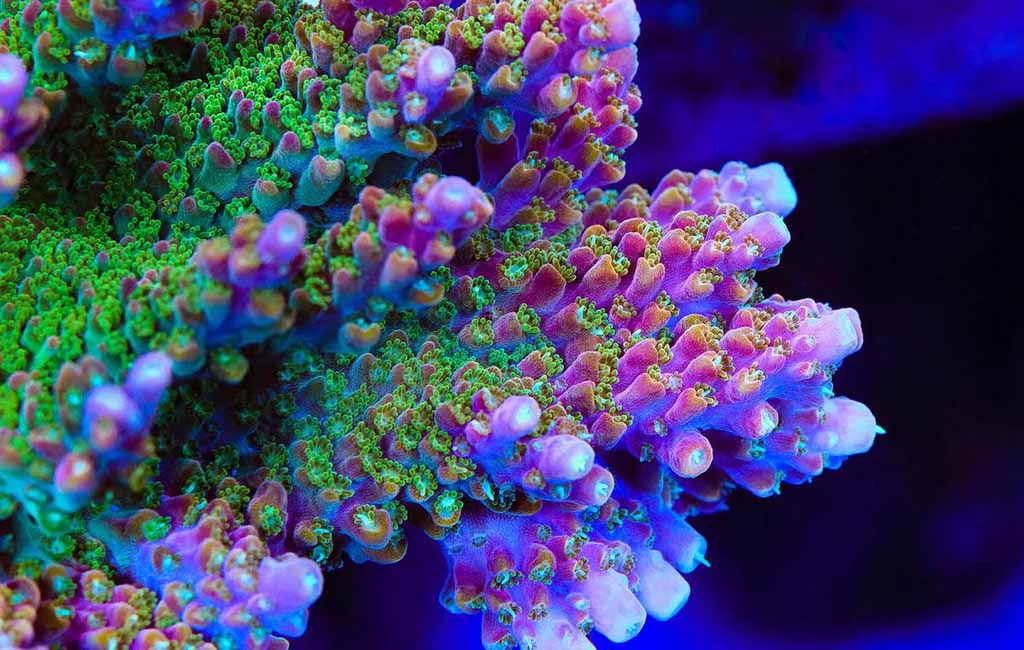
best light spectrum for coral growth
Lighting Requirement of Corals
There are approximately 6000 coral species. They either come under stony, LPS, or SPS coral. Each species has different lighting requirements. Therefore, knowing the specific light requirement for the species you want to grow in your tank is necessary. Here are some common and suitable aquarium coral species with their light requirement.
| Type | PAR | Light spectrum | Light intensity | Photoperiod (Hrs.) |
| Mushroom corals | 50–150 | Blue | low to moderate | 8–10 |
| Open brain coral | 50–150 | Blue | Optimal growth at low but can live up to moderate. | 8–10 |
| Acropora | 200–400 | Green and red | Moderate to high | 8–12 |
| Green Star polyp | 100–250 | Blue and white light, with less emphasis on the red and orange | Moderate to high | 8–10 |
| Montipora | 200–300 | Balanced spectrum with high blue | High | 8–10 |
| Buble coral | 150 | Bluish LEDs | Low | 8 |
| Candy Cane coral | 50–70 | White light with a good balance of blue light | Moderate | 8–10 |
| Hammer corals | 100–250 | Blue and violet | moderate to high | 8–10 |
| Sinularia | 50–150 | Blue and white | Moderate to high | 8–10 |
| Pulsing Xenia | 50–150 | Blue and white with a small amount of red | Moderate to high | 8–12 |
| Zoanthids | 50–200 | Blue | Medium | 8–12 |
| Closed brain corals | 100-200 | Predominately blue | Low to medium | 8–10 |
Best Light Spectrum for Coral Growth
In nature, corals grow under seawater, mainly under blue light. Therefore, the best heavily blue light spectrum for coral growth in a tank. It should also have a small amount of red, orange, and yellow light. However, avoid overexposure to these minute-level lights, i.e., other than blue. Briefly, it should mimic natural light.
Choose the Right Light for Various Corals Color
Light has an impact on coral coloration and growth. Therefore, it is necessary to select a proper light for optimal coral growth in the tank. An appropriate light installation will promote the optimal coloration and growth in your corals. Here is the procedure for optimal light selection for different and mixed types of coral reef tanks.
Know Your Coral Type
There are several coral types, including soft, LPS, and SPS. Identify the coral type in your tank. After identification, check their natural habitat lighting conditions, such as light color, intensity, photoperiod, etc.
Light Selection
After knowing your coral, choose the best light for your coral.
| Coral Type | Light Requirement | Product Suggestion |
| Soft Corals | Moderate light intensity with a dominant blue color. | HG088 |
| LPS corals | Full spectrum light with enough blue and white light combination | HG100 |
| SPS corals | High-intensity light with optimal PAR and light spectrum | HG107 |
Adjusting the Photoperiod
After selection, install the light in your tank according to the user manual. If your light has a timer, set it according to the photoperiod of the specific coral. Usually, it varies between 8 and 10 hours. Also, provide 2 to 4 hours for moonlighting.
Gradual Acclimation
At installation, don’t turn on the new light in your tank up to 100%. It can cause shock for the corals. To avoid the shock, start with 50% intensity. Gradually increase it to 100% within 1–2 weeks.
Monitoring
After introducing the light, keep an eye on it. Always check whether your light is improving growth or causing stress on corals. If it is causing any stress, adjust the intensity, spectrum, photoperiod, etc.
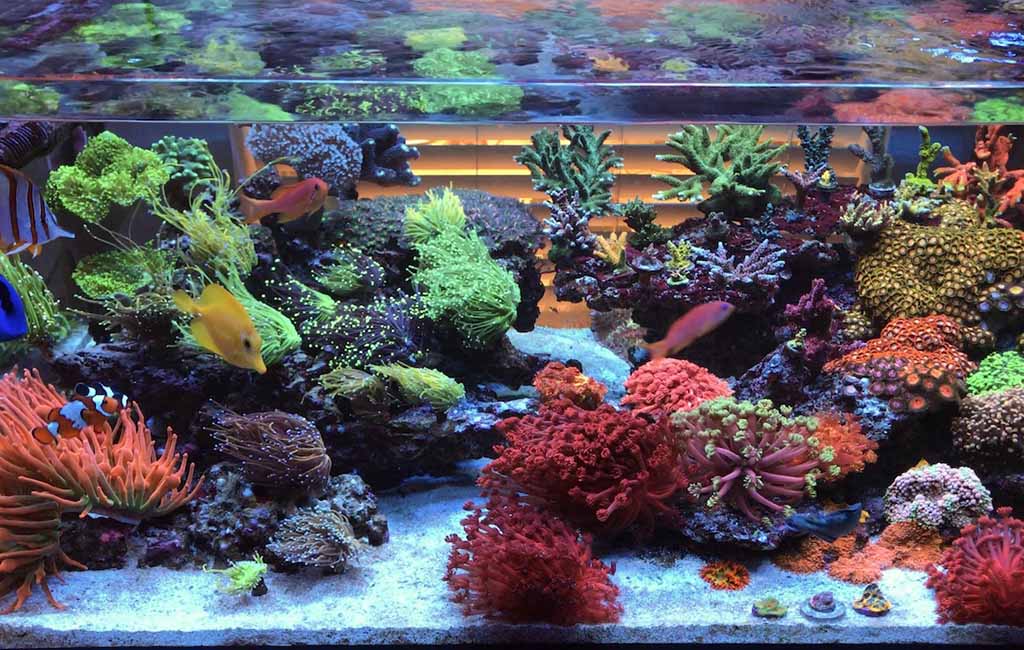
light settings for coral
How to Set Light for a Reef Tank with Various Corals?
Sometimes, aquariums have different types of corals. It makes the light selection decision quite hard. If you’re facing the same situation, here is a step-by-step light selection and setting guide.
Coral Placement and Needs
Place the soft corals at the bottom or shaded areas. They require low to moderate light intensity, i.e., 50–100 PAR, and blue spectrum, i.e., 450–500 nm.
LPS corals are one level up in lighting requirement from soft corals. Place it in the middle section of the tank as they require moderate light intensity, i.e., 75–150 PAR. A full spectrum light, i.e., 10,000 – 20,000 K, with a high blue color with emphasis on the coloration.
SPS corals require the highest light intensity, so place them in the upper or the high-intensity section. They require 200–350 PAR light with a blue and actinic spectrum, i.e., 400-500 nm.
Light Selection
Select a light of the following aspects. It should offer adjustability in intensity for various corals. It should provide full spectrum light with emphasis on blue wavelength. Moreover, it should offer channel customization, i.e., blue, white, UV, etc. You can use HG100 and HG107 marine light in SPS and LPS coral tanks. HG088 is suitable for low and moderate light requirements.
Light Spectrum Adjustment
Adjust the blue light spectrum, i.e., 450–500 nm, to promote fluorescence and color enhancement in all corals. Mimic the light with day lighting for growth and natural coloration. If you have a dominant SPS coral tank, set the actinic light, i.e., 400–450 nm. It’ll promote deeper pigment in the tank.
Intensity Adjustment
Use a PAR meter to adjust the light intensity at different tank levels. It should be 200–350 PAR at the top, 75–150 PAR at the middle, and 50–100 PAR at the bottom.
Photoperiod Setting
Different types of corals have different photoperiods. Roughly, full spectrum photoperiod lies between 8–12 hours per day. Turn on the light with the blue spectrum for 2–4 hours for the moonlight effect. Moreover, gradually turn on and turn off the light for proper dawn and dusk conditions. Sudden exposure to another phase can cause stress among corals.
Bringing It All Together
Corals give unique fluorescence under lighting that optimizes the tank look. Lighting glows the tank, causes color popping, produces light ripple, and glows the background. The moonlight effect creates a magical sighting.
They require an average of 10 hours full and 2–4 hours moonlight. Knowing your coral type, light selection, photoperiod, gradual acclimation, and monitoring are some key aspects for glowing your tank. For optimal growth, grow soft corals at the bottom, LPS corals in the middle, and SPS corals at the top.
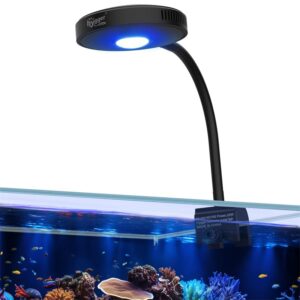
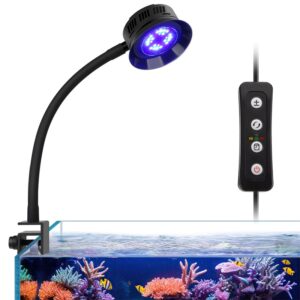


Leave a comment